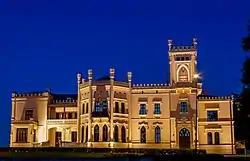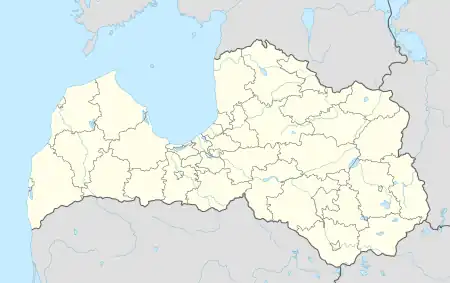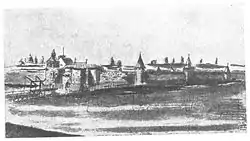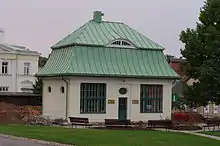Alūksne | |
|---|---|
Town | |
 | |
 Flag  Coat of arms | |
 Alūksne Location in Latvia | |
| Coordinates: 57°25′N 27°3′E / 57.417°N 27.050°E | |
| Country | |
| District | Alūksne Municipality |
| Town rights | 1920 |
| Government | |
| • Mayor | Dzintars Adlers |
| Area | |
| • Total | 14.27 km2 (5.51 sq mi) |
| • Land | 10.68 km2 (4.12 sq mi) |
| • Water | 3.59 km2 (1.39 sq mi) |
| Elevation | 217 m (712 ft) |
| Population (2023)[2] | |
| • Total | 6,262 |
| • Density | 440/km2 (1,100/sq mi) |
| Time zone | UTC+2 (EET) |
| • Summer (DST) | UTC+3 (EEST) |
| Postal code | LV-430(1-2) |
| Calling code | +371 643 |
| Climate | Dfb |
| Website | visitaluksne |
Alūksne (German: ⓘ[3])) is a town on the shores of Lake Alūksne in northeastern Latvia near the borders with Estonia and Russia. It is the seat of Alūksne municipality. Alūksne is the highest elevated Latvian city, located in East Vidzeme Upland at 217 m[4] above sea level. The high elevation of the city affects the social and physical arrangement of the place.
History

The region around Lake Alūksne was originally settled by Finnic-speaking tribes, and from the 8th-12th centuries by Latgalians. The date of settlement at the current location of the town, then known as Olysta, Alyst, and Volyst, is given in the chronicles of Pskov as 1284. The later name "Alūksne" comes from the Latgalian word olūksna, meaning a spring in the forest.
The Latgalian inhabitants of the settlement were conquered by the German crusaders of the Livonian Order in 1224.[5] They built in 1284 a wooden castle named Marienburg (after Mary, the mother of Jesus) on a nearby island, which served to protect trade routes from Riga to Pskov. The town which developed near the castle also became known as Marienburg. In 1342 new castle from stone was built on the largest isle of Lake Alūksne.[6]
Marienburg was captured by the troops of Ivan IV of Russia in 1560 during the Livonian War. It was incorporated into the Polish–Lithuanian Commonwealth in 1582. The town became part of the Swedish Empire in 1629.

Ernst Glück, a Lutheran clergyman and the first translator of the Bible into Latvian, founded the first Latvian language schools in Vidzeme in 1683. It is now the Ernst Glück Bible Museum. The Russian army led by Sheremetyev captured the town during the Great Northern War in 1702, doing great damage to the area and deporting all the inhabitants, including Glück and his foster daughter, Marta Skavronska, who later became Empress Catherine I of Russia. After 1721 Alūksne became part of the Livonia Governorate but for many decades it was a devastated and minor settlement. Alūksne started development in the 19th century when it became a major trading centre. Further development was stimulated with the opening of narrow gauge railway line Stukmaņi-Gulbene-Alūksne-Valka in 1903.
During the Latvian War of Independence Alūksne was one of the first major settlements in Vidzeme which was liberated by Latvian Army in May 1919. In 1920 Alūksne was granted town rights. Since 2009 it is an administrative center of the Alūksne municipality. During World War II, Alūksne was under German occupation from 5 July 1941 until 19 August 1944.[7]
The town's island is known as Pils salas (Castle Island) and Maria Island. Alūksne Castle is now used as an open-air theater.
Nature
Alūksne lake
Alūksne is located on the shore of Lake Alūksne, which is the eleventh largest lake in Latvia. There are four islands in the lake - Cepurītes or Love Island, Long Island, Tīklu Island and Castle Island. The average depth of the lake is about 7 meters. The deepest place reaches up to 20 meters.
Climate
Alūksne has a humid continental climate (Köppen Dfb).
| Climate data for Alūksne, Latvia (1991-2020 normals, extremes 1945-present) | |||||||||||||
|---|---|---|---|---|---|---|---|---|---|---|---|---|---|
| Month | Jan | Feb | Mar | Apr | May | Jun | Jul | Aug | Sep | Oct | Nov | Dec | Year |
| Record high °C (°F) | 8.8 (47.8) |
10.9 (51.6) |
18.2 (64.8) |
26.5 (79.7) |
30.2 (86.4) |
32.0 (89.6) |
33.3 (91.9) |
32.9 (91.2) |
29.4 (84.9) |
21.1 (70.0) |
13.1 (55.6) |
10.8 (51.4) |
33.3 (91.9) |
| Mean daily maximum °C (°F) | −2.8 (27.0) |
−2.4 (27.7) |
2.5 (36.5) |
10.2 (50.4) |
16.4 (61.5) |
19.9 (67.8) |
22.4 (72.3) |
20.9 (69.6) |
15.3 (59.5) |
8.2 (46.8) |
2.3 (36.1) |
−1.1 (30.0) |
9.3 (48.8) |
| Daily mean °C (°F) | −4.9 (23.2) |
−5.1 (22.8) |
−1.0 (30.2) |
5.6 (42.1) |
11.3 (52.3) |
15.0 (59.0) |
17.4 (63.3) |
16.1 (61.0) |
11.1 (52.0) |
5.3 (41.5) |
−0.4 (31.3) |
−3.0 (26.6) |
5.7 (42.3) |
| Mean daily minimum °C (°F) | −7.5 (18.5) |
−8.1 (17.4) |
−4.6 (23.7) |
0.8 (33.4) |
5.7 (42.3) |
9.9 (49.8) |
12.6 (54.7) |
11.6 (52.9) |
7.4 (45.3) |
2.6 (36.7) |
−1.6 (29.1) |
−5.1 (22.8) |
2.0 (35.6) |
| Record low °C (°F) | −37.4 (−35.3) |
−36.8 (−34.2) |
−28.8 (−19.8) |
−15.9 (3.4) |
−5.8 (21.6) |
−0.3 (31.5) |
2.9 (37.2) |
0.7 (33.3) |
−5.1 (22.8) |
−10.6 (12.9) |
−20.6 (−5.1) |
−36.8 (−34.2) |
−37.4 (−35.3) |
| Average precipitation mm (inches) | 55.4 (2.18) |
43.9 (1.73) |
40.8 (1.61) |
40.5 (1.59) |
63.1 (2.48) |
90.3 (3.56) |
82.9 (3.26) |
82.9 (3.26) |
63.7 (2.51) |
73.8 (2.91) |
61.0 (2.40) |
52.0 (2.05) |
750.3 (29.54) |
| Average precipitation days (≥ 1 mm) | 14 | 11 | 11 | 8 | 10 | 13 | 11 | 12 | 12 | 13 | 14 | 14 | 143 |
| Mean monthly sunshine hours | 30.9 | 60.2 | 133.3 | 199.0 | 278.4 | 273.1 | 284.2 | 243.1 | 151.7 | 73.5 | 28.3 | 20.5 | 1,776.2 |
| Percent possible sunshine | 14 | 24 | 37 | 47 | 55 | 52 | 54 | 53 | 41 | 24 | 12 | 10 | 41 |
| Source 1: LVĢMC[8][9] | |||||||||||||
| Source 2: NOAA (precipitation days 1981-2010)[10] | |||||||||||||
Demographics
Within existing limits, according to CSB data.
|
| ||||||||||||||||||||||||||||||||||||
| Source: Latvian Geospatial Information Agency[11] | |||||||||||||||||||||||||||||||||||||
Sister cities
Gallery
 Soldiers of the Latvian National Armed Forces in Alūksne in the 1930s
Soldiers of the Latvian National Armed Forces in Alūksne in the 1930s Lutheran church in Alūksne
Lutheran church in Alūksne.JPG.webp) Narrow gauge railway in Alūksne
Narrow gauge railway in Alūksne Alūksne town centre
Alūksne town centre

 Alūksne orthodox church
Alūksne orthodox church Alūksne Art School
Alūksne Art School Alūksne cemetery
Alūksne cemetery Alūksne Castle ruins
Alūksne Castle ruins
References
- ↑ "Reģionu, novadu, pilsētu un pagastu kopējā un sauszemes platība gada sākumā". Central Statistical Bureau of Latvia. Retrieved 18 January 2023.
- ↑ "Iedzīvotāju skaits pēc tautības reģionos, pilsētās, novados, pagastos, apkaimēs un blīvi apdzīvotās teritorijās gada sākumā (pēc administratīvi teritoriālās reformas 2021. gadā) 2021 - 2022". Central Statistical Bureau of Latvia. Retrieved 3 October 2023.
- ↑ Rene Levoll: "The last motor race of the empire (ee: Impeeriumi viimane motovõistlus, de: Das letzte Autorennen des Imperiums)", Tallinn 2014, Estonian Old Technics Museum Foundation, page 81 "list of former and present place names of places"
- ↑ "Latvijas augstāko pilsētu TOP 20". neogeo.lv. 2010-05-24. Retrieved 2014-12-18.
- ↑ "Alūksnes vēsture". VisitAluksne (in Latvian). Retrieved 2022-01-02.
- ↑ "Livonian Order Castle Ruins in Alūksne". Latvia.travel. Retrieved 14 July 2022.
- ↑ Освобождение городов
- ↑ "Klimatisko normu dati". Latvian Environment, Geology and Meteorology Centre. Retrieved January 12, 2023.
- ↑ "Gaisa temperatūras rekordi". Latvian Environment, Geology and Meteorology Centre. Retrieved January 12, 2023.
- ↑ "World Meteorological Organization Climate Normals for 1981-2010". National Oceanic and Atmospheric Administration. Retrieved January 12, 2023.
- ↑ CSD data
- ↑ "International Relations". joniskis.lt. Retrieved 29 April 2014.